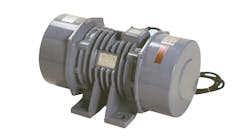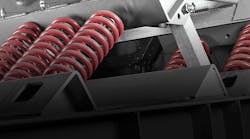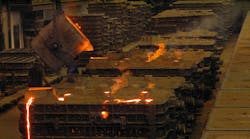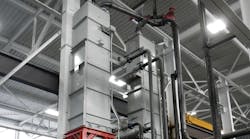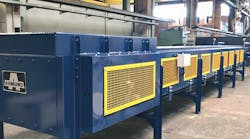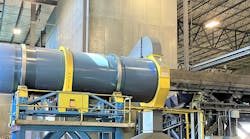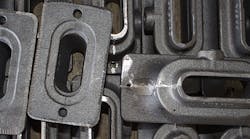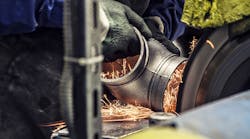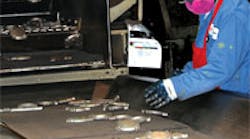When a fresh casting leaves its mold, the production process is far from over. In many foundries, systems and equipment for removing cores and sand, inside and out, represent a significant portion of capital and operating costs. Developers of new products and equipment for metalcasting invariably emphasize the “ruggedness” of their offerings. They hold up under “hostile conditions.”
But, with most cleaning systems this is just taken for granted. In some ways, all these vibrating, blasting, and tumbling machines contribute to the inhospitable setting, so new designs have to go beyond ruggedness.
Durability is just one quality needed in these applications. High-throughput, availability, and cleanliness are often equally important. Each was cited by Bentonville Casting Co. in its adoption of a new Didion International Inc. rotary media drum.
It’s Didion’s newest rotary model, the MD-80 in the Mark 5 series. It performs shakeout, sand conditioning, double sand screening, casting cleaning, and casting cooling in a single step. The process also helps metalcasters keep their foundries clean, because it reduces the volume of airborne silica dust.
In addition, the shakeout system separates core sand from green sand and discharges them independently at different points. Tramp metal and other debris are removed, too, and the return sand is blended and conditioned for temperature and moisture consistency.
For Bentonville Casting, there is the additional advantage of equipment scale. It replaced an earlier model Mark 5 drum with the MD-80, and now effectively cleans a wider range of its gray and ductile iron castings. And, the Didion MD-80 is that it has ended Bentonville’s need to knock out cores by hand. With the new rotary drum, those castings can be handled together with the other products, and the cores are knocked out in the process.
Shaking up the process
New cleaning technologies emerge in stages, rarely as wholesale designs. According to General Kinematics’ R&D/ Marketing director Tom Muschoot, there are two options for foundries seeking the optimal drum technology — vibratory drums and rotary drums — and each has advantages in certain applications, and disadvantages in others.
There are two types of vibratory drums, for media and non-media applications. Vibratory drums are optimal for grey iron, green sand, no-bake, brass, or any foundry where it’s necessary to reduce or eliminate casting damage. Benefits include simpler dustcollection and air-system attachments, the ability to add peripheral attachments (e.g. water addition), and the ease of matching auxiliary equipment.
Non-media vibrating drums, like General Kinematics Vibra-Drum, deliver high-capacity throughput, superior material motion for efficient sand and casting processing. The Vibra-Drum’s natural-frequency vibratory action produces a beneficial internal rotation of the sand and casting bed that quickly reduces sand lumps and cleans surface sand from castings, without causing the castings to impact or drop. Both castings and sand are discharged onto a two-mass sand separator to screen the granulated sand from the castings. The sand separator’s motion will remove any remaining core sand from the castings.
Rotary drums have been used as a simple, cost-effective solution for processing castings in all types of foundries. They are particularly popular with ductile iron foundries, where gates, runners and sprue need to be removed from castings prior to blast cleaning. Due to the lift and drop action of rotary devices, tangling of castings and sprue is also reduced.
Innovations in rotary technology, such as GK’s recent Ducta-Series introduction, allow ductile iron foundries to process castings effectively without high maintenance costs. Drums in this series have a heavy-duty rotary shell with a patent-pending wear plate liner system. This reduces the maintenance costs of replacing cast liners, so only portions of the liner can be replaced, as needed.
Patent-pending Ducta-Series drums extract sand and media through multiple discharge points, and vibratory collection technology allows the foundry to direct the sand in any direction, for optimal process layout.
Rotary drums are designed to perform specific processes. Drums such as the Ducta-Sprue are specifically engineered to clean and break up sprue, gates, and risers quickly, for cleaner recycling of material back to the melt department. For post molding line applications, the Ducta-Screen rotary shakeout removes sand from castings and removes sprue and gates from castings.
For rotary shakeout and cleaning, the Ducta-Clean media drum cleans, de-gates, de-sprues, removes tramp metal, and screens sand, as well as uses media to clean ductile castings prior to the blast process.
One machine for all
Carrier Vibrating Equipment’s recent contribution to the casting cleaning technology is the patented Delta Phase shakeout, which it reports will lower maintenance costs, reduce or eliminate casting damage, and maximize sand removal. A single Delta Phase shakeout machine can serve a foundry with various molding processes, mold sizes, metal types, and casting designs.
The Delta Phase was designed for low maintenance and higher availability. It can be used for sand to metal ratios as low as 5:1 and as high as 60:1. The provided controls accommodate an unlimited number of recipes for diverse casting production. In addition to sand-casting separation, the shakeout may be used for lump breakers, sprue cleaning, and casting de-accumulation.
The key feature of the Delta Phase shakeout is direct-drive technology: it’s a simple, sturdy design that uses long-life, spherical roller bearings and eccentric weights to drive the system. The eccentric weights are inertially synchronized, to eliminate any need for gearboxes or timing belts.
Compared to shakeout machines with a two-mass natural-frequency design, the Delta Phase shakeout is not susceptible to upsets during operation or long downtime for cleaning and maintenance. Another advantage of its direct-drive design is that it will not overstroke, which causes structural damage to many machines.
| Demand-Driven R&D leads to “super durable” zinc shot Established by Battelle Memorial Institute, in 1979, Transmet roots in R & D. While it developed the new material in response to customers’ concerns about the rising price of zinc shot, due raw material and transportation costs, it maintains that the new product also improves the durability and performance of the shot-blasting media. |
The Delta Phase shakeout uses simple, reliable electronics to control the angle of vibration and operating frequency precisely. Changing the vibration angle controls the conveying speed and retention time of castings on the shakeout deck, optimizing sand removal. The operator can accurately and automatically change the angle and frequency, even on the fly.
A wide variety of casting shapes and sizes can be processed easily using pre-programmed settings, to optimize sand removal without damaging the casting. Using VFD and PLC technology, the angle of vibration and/or operating frequency is changed to meet each unique shakeout requirement.
High-availability, low maintenance
Other cleaning systems are more process specific. Wheelabrator supplied a threewheel continuous rocker barrel machine for Neptune Technology Group Inc., Tallassee, AL. It’s an in-line system used to clean castings or forgings, offered in a range of sizes for handling loads of five to 25 tons/hour. Neptune is one of the largest domestic suppliers of brass water meters.
Prior to this machine’s installation, the brass water meters (which are green-sand castings) were cleaned by one of two Wheelabrator Tumblast (28 ft3) systems. Neptune also operates a Wheelabrator spinner hanger, which cleans large lost-foam castings for water-meter housings.
Even though Neptune’s rocker barrel machine has three blast wheels, Neptune normally operates efficiently with just two blast wheels. The operator can select which wheels to use from the control panel. Alternating blast wheels lengthens the maintenance intervals between blade changes for each wheels. This also extends the life of the barrel liners and curtain seals for reduced maintenance costs. Having an extra blast wheel ensures minimal downtime due to wheel-related problems — a significant advantage in continuous blasting.
After in-line sand shakeout and cooling, the castings are delivered to the rocker barrel via an inclined belt and shaker load conveyor, providing process improvements to the overall automated operation. The drive that rocks the barrel is controlled from a touch screen on the operator panel. An adjustable range of rocking motion ensures different shaped castings can be tumbled satisfactorily. A separate mechanism sets the adjustable decline angle for controlling the flow of castings through the machine.
The control system allows both manual and automatic selection of the work conveyor parameters to compensate for changes in part configurations and cleaning requirements. The combination of a variable decline angle and rocking angle for the work conveyor barrel provides a high degree of control for achieving effective blast coverage. Depending on daily production requirements, the rocker barrel satisfies Neptune’s surface preparation requirements in one to two shifts.
More recently, Neptune upgraded its rocker barrel system with a Wheelabrator EMP (equipment modernization program) by installing front support rolls with liners, and two new rolls to the back-end of the machine. After a barrel-liner rebuild, Neptune was able to replace individual liners, saving time and money.
The continuous rocker barrel design is fitted with Wheelabrator’s EzeFit blast wheels, which are designed to be longwearing and easy-to-maintain. To help meet various surface finish requirements, interchangeable blade sets provide larger or smaller wheel diameters for a low-cost way to adjust the abrasive velocity. A variableflow option for abrasive valves offers additional adjustment capability for fine-tuning cleaning and controlling operating costs.
The machine’s abrasive recycling system includes a lower shaker reclaim conveyor, bucket elevator, rotary screen, double-lip air wash separator, and storage hopper, to recover, clean, and store the blast media. For cleaning ferrous parts, magnetic separation is available also. The work conveyor barrel is a selfdraining, variable-slope design with a heavy manganese frame and replaceable manganese liners.
Electric Industrial Vibrator Improves Decoring Cycle Time
Herschal Products has adopted the Cougar Industries’ B-Series electric industrial vibrator to improve its automated knockout machines, for decoring aluminum castings. In operation, they are proving to be successfully reducing cycle time and process cost.
The B-Series industrial vibrators are electric motor-driven eccentric rotary vibrators used to promote the flow of difficult bulk solids in many applications, including from bins, hoppers and silos. Promoting material flow requires overcoming the cohesive strength of the material and the friction between the material and bin wall within the cone section of the vessel.
B-Series vibrators can be provided with a maximum force output of 16,500 lbs. Units can be provided to operate at speeds ranging from as low as 900 to as high as 3,600 rpm. Single-phase power units are standard, but units operating on 3-phase power are available, too.
